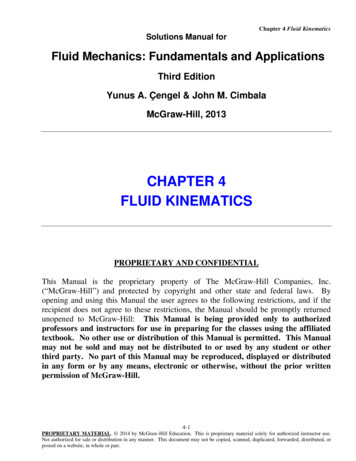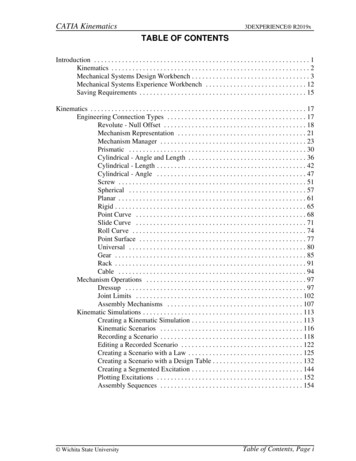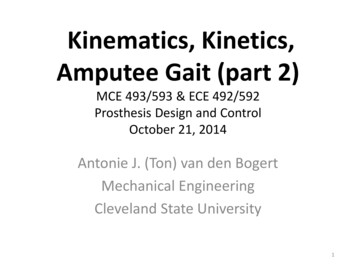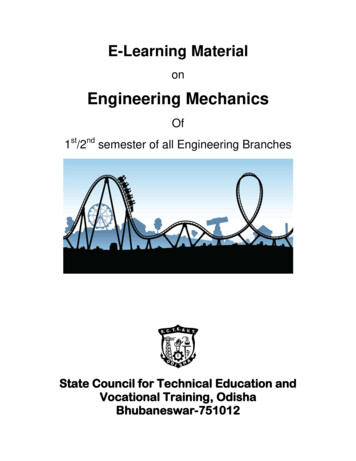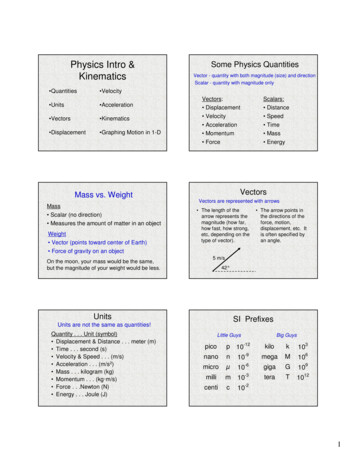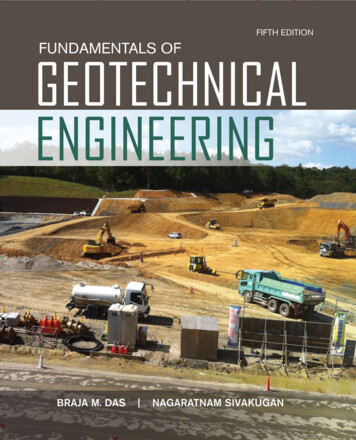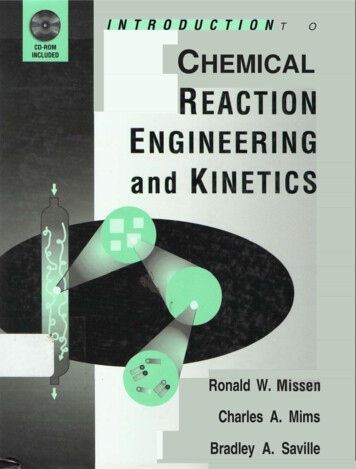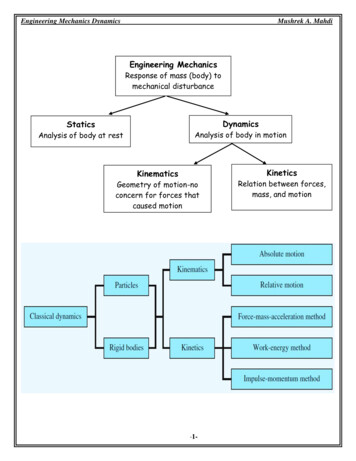
Transcription
Engineering Mechanics DynamicsMushrek A. MahdiEngineering MechanicsResponse of mass (body) tomechanical disturbanceDynamicsStaticsAnalysis of body in motionAnalysis of body at restKineticsKinematicsGeometry of motion-noconcern for forces thatcaused motion-1-Relation between forces,mass, and motion
Engineering Mechanics DynamicsMushrek A. MahdiBasic Concepts:A particle: is a body of negligible dimensionsRigid Body: is that body whose changes in shape are negligible compared with its overalldimensions or with the changes in position of the body as a whole, such as rigid link, rigiddisc .etc.Absolute motion: the motion of body in relative to another body which is at rest or to a fixedpoint located on this body.Relative motion: the motion of body in relative to another moved body.Scalar quantities: are those quantities which have magnitude only e.g. mass, time, volume,density .etc.Vector quantities: are those quantities which have magnitude as well as direction e.g. velocity,acceleration, force .etc.-2-
Engineering Mechanics DynamicsMushrek A. MahdiChapter TwoKinematics of ParticlesKinematics: is that branch of dynamics which is responsible to study the motion ofbodies without reference to the forces which are cause this motion, i.e it’s relate themotion variables (displacement, velocity, acceleration) with the time1. Rectilinear Motion:The particle moves along a straight line path. The kinematics of a particle is described byspecifying, at any given instant (the particle’s position, velocity and acceleration).Position(s): The straight line path of a particle will be defined using one coordinate axis s.Displacement (:The displacement of the particle is defined as the change in its position(1)Where:: Final position of particle: initial position of particleNote:is positive( ) ifis negative (-) iflocated to the right of .located to the left of . The displacement of a particle is also a vector quantity, and it should be distinguished fromthe distance the particle travels. The distance traveled is a positive scalar that represents the total length of path over whichthe particle travels.-3-
Engineering Mechanics DynamicsMushrek A. MahdiVelocity (v):average velocity,(2)( ) , orinstantaneous velocity,( )𝒅𝒔𝒅𝒕𝒗(3)𝒔The magnitude of the velocity is known as the speed.Average speed , ()(𝒗𝒔𝒑 )𝒂𝒗𝒈𝑺𝑻𝒕(always positive)(4)Velocity units are: m/s or ft/sFor example,(-)()( )Acceleration (a):average acceleration,(5)( ) , orInstantaneous acceleration,𝒂𝒅𝒗𝒅𝒕𝒗𝒅𝟐 𝒔𝒅𝒕𝟐𝒔(6)-4-
Engineering Mechanics DynamicsNote: Both&Mushrek A. Mahdican be either positive or negative.From equations (3) & (6) by eliminating the time (𝒂 𝒅𝒔), we get;(7)𝒗 𝒅𝒗A. Constant acceleration, (:1- ,𝒗at𝒗𝟎𝒂𝒄 𝒕(8)2 𝒔,,𝒔𝟎𝒗𝟎 𝒕𝟏𝒂𝒄 𝒕𝟐𝟐,3- at(9)at 𝒗𝟐𝒗𝟐𝟎𝟐𝒂𝒄 𝒔𝒔𝟎-5-(10)
Engineering Mechanics DynamicsMushrek A. MahdiB. Acceleration given as a function of time ( ): (11)Also, if (12)C. Acceleration given as a function of velocity ( ): (13)Or, (14)D. Acceleration as a function of displacement ( ) (15)Notes:1. If the particles (car, bicycle, train, etc.) start from rest, then2. If the particle is stopped or take off , then3.or( when the body falls to the earth). Neglected the airresistant-6-
Engineering Mechanics DynamicsMushrek A. MahdiGrapher interpretation:1- The s-t , v-t and a-t graphes2- Theandgraphics( )Accel. velocity (slop ofgraph)-7-
Engineering Mechanics DynamicsMushrek A. MahdiEx. (1): The car in moves in a straight line such that for a short time its velocity is defined by, where is in seconds. Determine its position and acceleration when. WhenSol.( ) When ,sec. ,Ans.sec.Ans.( )WhenNote: The formulas for constant acceleration cannot be used to solve this problem, because theacceleration is a function of time.Ex. (2): During a test a rocket travels upward at 75 m/s, and when it is 40m from the ground itsengine fails. Determine the maximum heightreached by the rocket and its speed just beforeit hits the ground. While in motion the rocket is subjected to a constant downward accelerationofdue to gravity. Neglect the effect of air resistance.Sol.atAt maximum height,(constant)Path A-B()-8-
Engineering Mechanics DynamicsMushrek A. MahdiAns.Path B-C()Ans.(The negative root was chosen since the rocket is moving downward)Or, Path A- C()Ans.Ex. (3): The position of a particle along a straight line is given by, where is in seconds. Determine the position of the particle whenand the totaldistance it travels during thetime interval. Hint: Plot the path to determine the total distancetraveled.Sol.:The times when the particle stops are-9-
Engineering Mechanics DynamicsMushrek A. MahdiAns.Ex. (4): A motorcyclist travels along a straight road with the velocity described by the graph.Construct the s-t and a-t graphs. AtSol.:s–t Graph:For the time intervalthe initial condition is,whenForthe initial condition iswhen-10-
Engineering Mechanics DynamicsMushrek A. MahdiEx. (5): The a–s graph for a jeep traveling along astraight road is given for the first 300 m of its motion.Construct the 𝑣– 𝑠 graph. At 𝑠𝑣Sol.:-11-
Engineering Mechanics DynamicsMushrek A. Mahdi-12-
Engineering Mechanics DynamicsMushrek A. MahdiEx. (6): Automobiles A and B are traveling in adjacent highway lanes and at t 0 have thepositions and speeds shown. Knowing that automobile A has a constant acceleration ofand that B has a constant deceleration of, determine (a) when and where A willovertake B, (b) the speed of each automobile at that time.Sol.:Motion of Auto. A:Motion of Auto. B:(a) A overtakes B atFrom Eq. (2):(b) Velocities whenAns.Ans.-13-
Engineering Mechanics Dynamics Mushrek A. Mahdi -3-Chapter Two Kinematics of Particles Kinematics: is that branch of dynamics which is responsible to study the motion of bodies without reference to the forces which are cause this motion, i.e it's relate the
